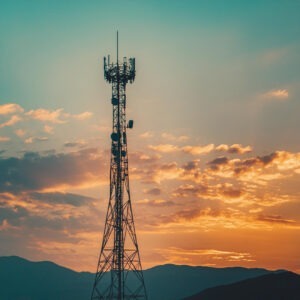Wenn wir an Standortbestimmung denken, kommen uns häufig globale Navigationssatellitensysteme...
WeiterlesenIn the rapidly evolving mobile communications landscape, staying abreast of evolving standards is critical. From the early days of analog cellular networks to the cutting-edge technologies of 5G, each generation has brought significant advances to meet the ever-growing needs of users and industries. In this article we look at the development of the individual mobile communications standards and examine the differences between the old and new standards from today’s perspective.
A brief history of mobile communications standards
1G
First Generation
Lay the foundation
Analogue mobile networks were introduced in the 1980s with the first generation of mobile communications, 1G. Although primitive by today’s standards, 1G networks revolutionized telecommunications by enabling simple voice calls over cellular networks and marking the beginning of mobile connectivity.
2G
Second Generation
Digital revolution
With the advent of 2G networks in the 1990s, digital communications became the norm. 2G offered improved voice quality, reduced interference and introduced breakthrough services such as SMS (Short Message Service). GPRS (General Packet Radio Service) paved the way for basic data transmission and ushered in the era of mobile Internet surfing and emailing on the go.
3G
Third Generation
The age of data
The introduction of 3G networks in the early 2000s marked a significant advance in mobile communications. Offers faster data speeds and enhanced data services, 3G-enabled video calling, multimedia messaging and mobile web browsing with greater efficiency. Technologies such as UMTS (Universal Mobile Telecommunications System) and CDMA2000 gave users unprecedented connectivity and paved the way for the mobile data revolution.
4G
Fourth Generation
The age of connectivity
The 4G networks introduced in the late 2000s and early 2010s led to a paradigm shift in mobile communications. With faster data speeds, lower latency and improved efficiency, 4G enabled seamless HD video streaming, online gaming and Voice over Internet Protocol (VoIP) services. The widespread adoption of LTE (Long-Term Evolution) and WiMAX technologies transformed mobile devices into powerful tools for communication and productivity.
5G
Fifth Generation
The future
The latest standard, 5G, promises to revolutionize mobile communication once again. With ultra-fast data speeds, ultra-low latency and massive connectivity, 5G opens the doors to a world of possibilities. From augmented reality to autonomous vehicles and Internet of Things (IoT) applications, 5G will transform industries and redefine the way we live, work and connect.
The shutdown of older technologies
While each generation of mobile communications standards has brought tremendous benefits, progress inevitably results in older technologies becoming obsolete. Reasons for phasing out older technologies include:
- technological advances,
- frequency efficiency,
- network modernization,
- market demand,
- regulatory factors
- and the development of the technology itself.
As newer technologies offer superior performance, efficiency and compatibility, phasing out older technologies is becoming a necessary step in the development of mobile communications networks.
However, a shutdown does not happen overnight. This process takes place over several years or decades. The shutdown of a technology also means that systems based on this technology must be prepared for a change and possibly converted. This becomes all the more complex the more technology is intertwined with social life.
An example: Is 2G an outdated technology these days?
You hear it again and again here and there: the shutdown of 2G. Although some countries have already implemented this and 2G is an older technology, in today’s context these networks still offer several advantages, especially in certain situations and regions. In the following sections we look at some of the key benefits:
1.
Comprehensive coverage
2G networks have been widely deployed around the world, providing reliable coverage, particularly in rural and remote areas where newer technologies such as 4G and 5G may not yet be available.
2.
Low cost
2G infrastructure and devices are generally more affordable compared to newer technologies because it is already in place and widely implemented. This makes 2G a cost-effective option for basic communication needs.
3.
Simplicity for basic communication
For basic voice calls and text messaging (SMS), 2G is sufficient and provides reliable service without the need for higher data speeds or advanced features.
4.
Lower bandwidth requirements
2G networks require less bandwidth than 3G, 4G or 5G networks, which can be beneficial in areas with limited spectrum availability or where bandwidth needs to be conserved.
5.
Compatibility with older devices
Many older cell phones and IoT devices are designed to operate on 2G networks. Maintaining 2G networks ensures that these devices continue to function.
6.
Reliable in emergencies
In some cases, 2G networks can serve as a backup communications system in emergencies when newer networks are congested or unavailable.
Use cases where 2G is still relevant
1.
Emerging markets
In many developing countries, 2G remains the primary network for mobile communications due to its lower cost and greater availability.
2.
Rural and remote areas
In rural or remote areas where 4G and 5G infrastructure is not yet deployed, 2G provides the necessary connectivity for communications and basic internet access.
3.
Simple cell phones
Feature phones (basic mobile phones) that focus on voice calls and SMS are often based on 2G networks. These phones are popular among users who don’t need advanced smartphone features.
4.
Machine-to-Machine (M2M) communication
2G is widely used in M2M applications such as GPS trackers, surveillance systems and point-of-sale terminals where high-speed data is not required.
5.
Cost-sensitive applications
For cost-sensitive applications and services, 2G offers a more economical option compared to using new and more expensive network technologies.
Conclusion
In summary, the development of mobile communications standards has been characterized by continuous innovation and progress. From the humble beginnings of analog voice calling to the ultra-fast, highly reliable connectivity of 5G, each generation has played a critical role in shaping the future of communications. As we seize the opportunities presented by 5G and beyond, we must not forget the lessons learned and the milestones achieved as they pave the way for a connected and powerful future.
And when you take on the next project that involves mobile communications, don’t forget to think about choosing the right standard. As we have seen with the example of 2G technology, although it is outdated compared to 3G, 4G and 5G, it still offers significant advantages in certain contexts. Be it widespread coverage, cost-effectiveness or suitability for basic communications and specific IoT applications, 2G remains (for now) a valuable technology in areas where advanced network infrastructure is not feasible or necessary.
Title image: Kabiur Rahman Riyad / unsplash
Have you always wanted to learn more about GPS? We explain a more detailed description of how the GPS position is determined in our article How GPS Works: How Your Device Knows Where You Are
Are you ready to explore GPS tracking solutions for your business or personal use?
Contact us today to discuss the perfect device for your needs!
Or take a look at our online shop.
Related blog articles
Mobile Kommunikationsstandards: Ein historischer Rück- und Ausblick
Von den Anfängen analoger Mobilfunknetze bis hin zu den Spitzentechnologien...
WeiterlesenA-GPS – Eine Technologie zur Verbesserung der GPS-Leistung
Assisted GPS (AGPS), eine Technologie, die eine schnellere Ortung, verbesserte...
Weiterlesen



